Multi-tower tanks of the USSR. Part of 3. Tank Grote (TG)
In 1930, a group of engineers from Germany arrived in the USSR at the invitation of Moscow, led by Edward Grote. Arriving engineers were given the task of developing a combat vehicle weighing up to 30 tons. It was planned that the created tank will receive powerful cannon armament - guns of 76,2 caliber and 37 mm. It was also planned that the new tank could receive additional weapons in the form of 5 machine guns.
The control over the group of German engineers arrived in the USSR was carried out by the Technical Department of the EGU OGPU. It was the head of this department who gave the task for the Grote group in 1930 year. According to the technical assignment, the German specialists were to create a tank with an armor thickness of at least 20 mm, which has an 35-40 km / h speed, armed with two guns. Questions of installation and placement of weapons, the range, the location of the ammunition and other issues were "given away" to the designers.
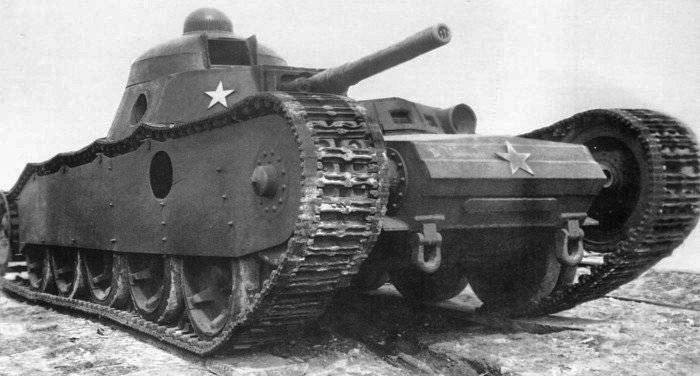
The OGPU, together with the NKVM, made a proposal to speed up work on the production and testing of a TG tank, believing that this task is the most important in the field of manufacturing experienced tanks on the 1931 year. At the same time, in the Soviet Union, Napoleon’s plans were simply to launch the production of these machines. For the development of their release in the 1931 year in the country planned to make the first batch, consisting of 50-75 tanks. At the same time, before the end of production and testing of prototypes of TG in the USSR, they planned to begin production of another experimental tank - T-24. Serial production of tanks Grote was planned to deploy at the facilities of the KhPZ (Kharkov Locomotive Plant) after the release of X-NUMX T-80 tanks and its withdrawal from production. Tank T-24 was considered only as a temporary measure. In total, by the year 24 in the USSR, they hoped to produce 1932 TG tanks.
Especially for the development of a new tank in Leningrad at the Bolshevik plant, a new design bureau, ABO-5, was created, which included a group of Grote specialists and a number of Soviet design engineers. At the same time, the development of a new Soviet tank was carried out in the strictest secrecy. The work on this project, on which great hopes were pinned, was monitored by representatives of the PBC and the government of the country. For example, on November 17 of 18-1930, the Bolshevik plant was personally visited by K. Ye. Voroshilov, who subsequently reported about him personally to Stalin. According to him, the readiness of the new tank was 85%, it remained to finish the work on the completion of the motor group, gearbox and some other components and assemblies. Voroshilov reported to Stalin that a sample of a breakthrough tank was assembled in a special workshop, in which about 130 people were employed, workers and technicians. In this case, the construction of the tank was delayed due to severe illness of Edward Grote. Despite this, the Soviet engineers expected to deliver a prototype of the machine by the 15-20 December 1930. However, the tank in these terms was not possible to complete.
The main reason for the delay in work on the prototype was the unreliable operation of a specially designed engine for this tank designed by Grote himself. For this reason, in April 1931, it was decided to abandon it and conduct a test cycle, temporarily installing a TG on the tank aviation M-6 engine. This decision required some redesign of the tank design, since the dimensions of the aircraft M-6 exceeded the dimensions of the Grote engine. As a result, a prototype TG tank was ready only by the beginning of July 1931. By this summer month, the car more or less managed to bring to the test.
The tank armament for the 1931 of the year was simply outstanding. The main armament of the tank was a gun A-19 (PS-19) caliber 76,2 mm, it was placed in the main turret. The gun had a semi-automatic loader, thanks to this solution, the gun’s rate of fire reached the 10-12 rounds per minute. At that time it was the most powerful tank gun in the world. In the hemispherical small tower, which was located above the main tower, the 37-mm PS-1 gun was installed. This gun was able to conduct circular fire. In addition, 2 machine guns DT, as well as 3 machine gun "Maxim", all caliber 7,62 mm, all machine guns had limited pointing angles were installed in the sides of the hull of the tank on ball mounts. Due to this, the armament of the Grote tank was three-level. Such a solution was supposed to provide an effective massive fire in all directions. The crew of the combat vehicle should have included 5-6 tank crews.
The special features of the design and layout of the new Soviet combat vehicle were the armored body extended to a 7,5 meter, a high under-turret box, a turret mixed to the stern of the tank, shielding of the chassis and a high tracked loop, the presence of an observation tower, and the use of pneumatic drives to control the transmission units. A large number of technical innovations were embodied in the TG tank, which in those years were not used on any serial tank. Such novelties were: fully welded armored corps, multi-tiered weapons system, the use of coil springs.
The fact that the progress of the project was reported personally to Stalin was completely justified. It should be noted that the resulting tank was worth it. The Tank Grote was at least 10 years ahead of similar tanks from other states, while it was ready at the beginning of the 1930s. The fighting machine favorably differed from all Soviet and foreign machines of its time, not only with its appearance, but also with its layout and manufacturing technology. The undoubted innovation, as mentioned above, was a fully welded body. The 37-mm gun mounted on the upper tier also had the ability to be used as an anti-aircraft gun.
The 76,2-mm cannon, designed by E. Grote and P. Syachevatova, located in the fixed main turret, had excellent ballistics. It is curious that according to the draft, the main tower was supposed to be rotating, but when it was manufactured, the turret shoulder welded to the tank body turned out to be deformed, and the lower main tower turned into a fixed wheelhouse. In the future, when the tank was put into mass production, this defect should have been eliminated.
The combat weight of the machine was 25 tons. The tank favorably differed from its predecessors by the presence of counter-reservation, the frontal armor of the hull was made three-layered. In especially dangerous places, its thickness reached 44 mm, while the booking of the sides of the tank reached 24 mm, and the booking of the tower and wheelhouse was 30 mm.
The chassis of the Grote tank in relation to each board consisted of large diameter 5-rollers, as well as 4-x supporting rollers of medium diameter and 2-x rollers of small diameter. The use of independent suspension on coil springs allowed for the vertical movement of the rollers to a distance of 220 mm, and the use of semi-pneumatic tires of the “Elastic” type ensured the combat vehicle a very mild course. In the factory workshop without tracks, a multi-ton machine could easily roll the entire 2-3 man from place to place.
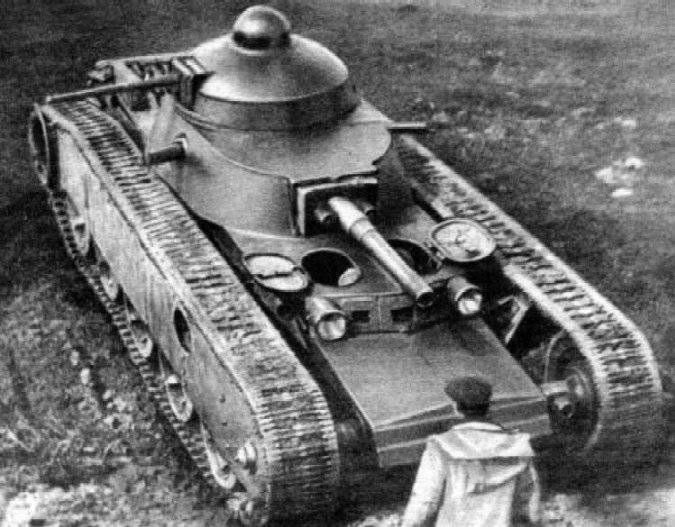
The gearbox used on the TG provided 4 transmissions forward and 4 transmission backward. This feature of the checkpoint allowed the combat vehicle to move forward and backward at identical speeds, which was considered an advantage for quickly removing the tank from the shelling zone or withdrawing the damaged vehicle from the battlefield. Gears with chevron engagement were used in the design of the gearbox. The question of controlling the combat vehicle was solved in a very original way - instead of using the usual levers, an aviation-type control knob was used on it. Turns were made by a corresponding deviation of this handle to the left or to the right. The use of pneumatic actuators provided a very easy process control tank.
Caterpillars TG were of original design, they were made from stamped parts and had great resistance to rupture. A curious feature was that all the rollers had brakes, which were intended for an emergency stop of the machine when the track was broken. According to the Grote patent, pneumatic actuators for brakes and controls were manufactured. Needless to say that all these decisions have inflated the price of the tank to the skies.
Tests of the new Soviet tank were carried out from July to October 1931. Tests have demonstrated both the obvious advantages of the machine and its drawbacks. The use of aircraft engine M-6 power 300 hp allowed the car to show on the test speed in 34 km / h. At the same time, the military praised the maneuverability of the tank and the smoothness of the work of the transmission, the ease of control of the combat vehicle, and the use of pneumatic drives. At the same time, it turned out that the transmission nodes overheated, and the TG passability on soft soils was unsatisfactory. The low efficiency of tracks and brakes on loose and viscous surfaces was also revealed.
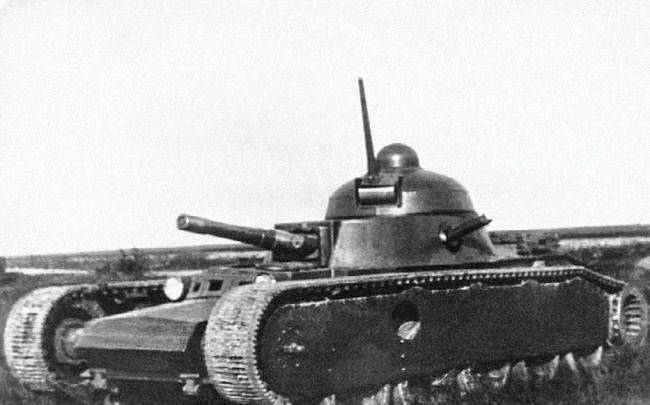
The guns of the tank were distinguished by good accuracy of shooting, the 76-mm gun was a very powerful weapon for its years and was distinguished by a high initial velocity of the projectile. But the tests showed that because of the narrowness in the fighting compartment, firing both cannons and machine guns simultaneously is simply impossible. In addition, the tank was distinguished by poor maintainability outside factory conditions. Even with the elimination of all the shortcomings, the Grote tank would be extremely difficult to launch into mass production. Another nail in the coffin lid of the tank was its cost - one Grote tank cost 1,5 a million rubles (for comparison, it was possible to build 25 tanks BT-2 with this money). As a result, in October 1931, the project was recognized as experimental and completely closed.
As a result, it was decided to abandon the services of the engineer Grote and start designing a much cheaper car based on his tank. The work on this project was entrusted to N. Barykov, who in 1932 and created the famous five-tower T-35 tank, which was very similar to the next British - the Independent tank, but with even stronger cannon weapons. Interestingly, the British military themselves were able to get a tank that was similar to the Soviet TG, only in 1940 year. This is a tank A.22 "Churchill", which was launched into serial production in 1941 under the designation Mk.IV. The very first models of this tank were equipped with an 40-mm cannon in the turret and an 75-mm cannon in the hull. The position of the cannon in the tank's hull was very low, it had an inadequate firing angle, and the nearby driver had limited visibility.
If we talk about the fate of the only assembled TG tank, it turned out to be bleak. To this day, this tank has not been preserved. After the completion of work on this project, the tank was sent for storage at the landfill in the Kubinka town near Moscow, and then at the WAMM named after Stalin, where the car was located until the beginning of World War II. Most likely, during the war, this unique tank was simply sent to the smelter.
Information sources:
http://lenta.ru/articles/2014/02/19/tanks
http://pro-tank.ru/sssr/59-t-28-and-tg?start=1
http://bronetehnika.narod.ru/tg/tg.html
http://tank.itishistory.ru/4_tank_31.php
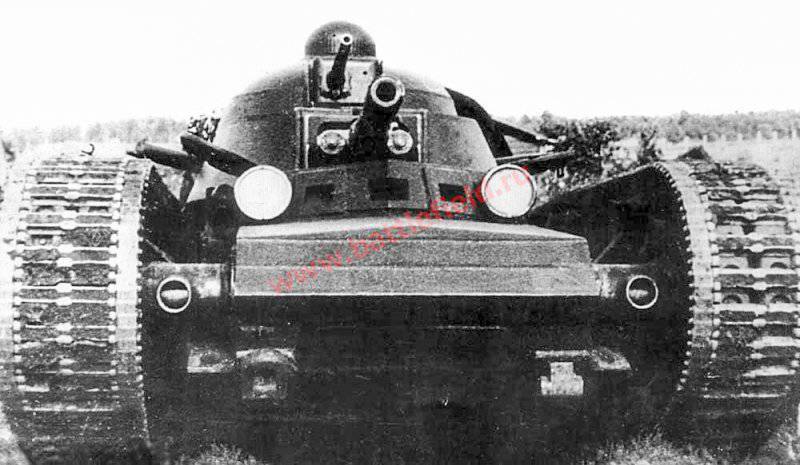
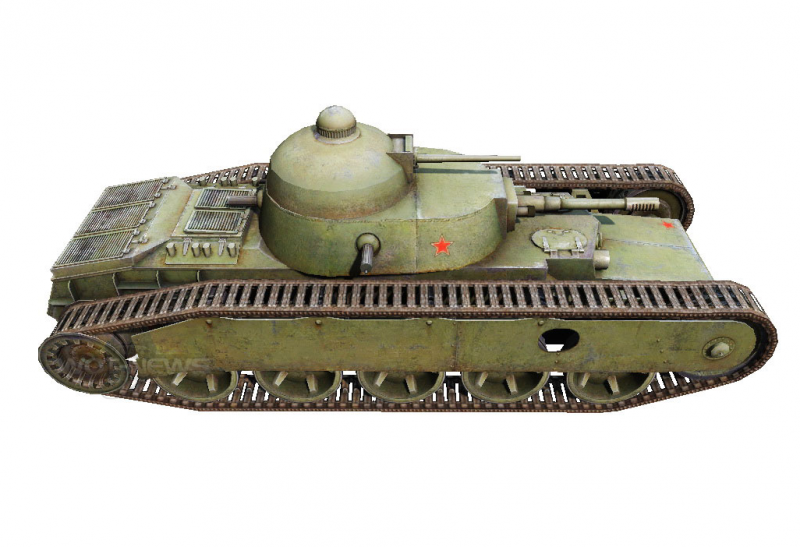
Information